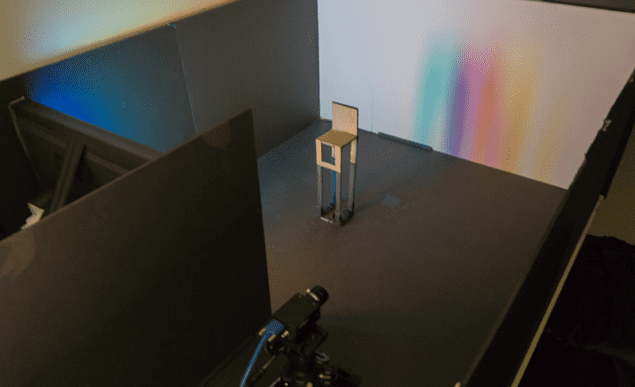
An ordinary digital camera has been used to acquire images of objects hidden round a corner. Vivek Goyal and colleagues at Boston University created their inexpensive non-line-of-sight imaging system using an algorithm to extract information from the shadow cast by an obscuring object. Their technique could lead to a diverse range of imaging applications based on low-cost components.
If the line of sight between a target object and a camera is blocked – by placing the object round a corner, for example — some of the light from the target can reach the camera via diffuse scattering from surrounding objects. This light carries information about the hidden object, but until now this information had to be captured and unscrambled using advanced detectors and algorithms before an image can be obtained.
One successful technique, for example, uses ultrashort laser pulses to illuminate a hidden object. Advanced optical sensors then pick up light that is scattered diffusely by a relay surface — which is essentially an extremely poor mirror. To reconstruct the image, the sensor measures both the arrival times and the incident angles of the light it receives. These data are then fed into an algorithm and an image is created. This requires expensive, highly-specialized equipment, which makes it impractical for many applications.
In the shadows
But now, Goyal’s team has achieved non-line-of-sight imaging with an ordinary digital camera and no need for measuring arrival times. Their algorithm analyses information that is contained in shadows cast by an obscuring object that is placed between the target object and the relay surface (see above figure). Their technique relies on the fact that shadows are not sharp, but rather have penumbrae at their edges. What is more, subtle variations in the colour and intensity of penumbrae light carry information about what lies behind the obscuring object.

In their experiment, the target object was a LCD TV screen that displayed a number of different colour images. A digital camera was used to capture penumbrae cast on the diffusely-reflecting relay surface. The team’s algorithm could determine the position of the obscuring object and also identify variations in brightness and colour within the target object. This enabled the system to acquire images of simple target objects including cartoon faces and Boston University’s logo with unprecedented resolution (see above figure).

Physicists look round corners in 3D
Goyal’s team now hopes to improve the technique so that it can determine the shapes of the obscuring objects; potentially allowing for 3D reconstructions of hidden scenes. Further research could soon create a diverse range of new imaging applications, including improvements of endoscopes for medical imaging, monitoring hazardous sites such as nuclear plants and burning buildings, and preventing collisions between vehicles.
The imaging system is described in Nature.



